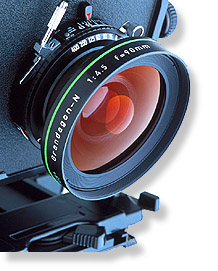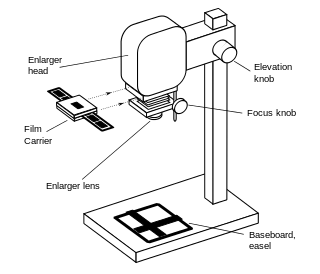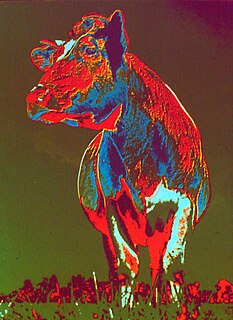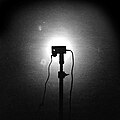
Photography is the art, application, and practice of creating durable images by recording light, either electronically by means of an image sensor, or chemically by means of a light-sensitive material such as photographic film. It is employed in many fields of science, manufacturing, and business, as well as its more direct uses for art, film and video production, recreational purposes, hobby, and mass communication.

Astrophotography, also known as astronomical imaging, is photography or imaging of astronomical objects, celestial events, and areas of the night sky. The first photograph of an astronomical object was taken in 1840, but it was not until the late 19th century that advances in technology allowed for detailed stellar photography. Besides being able to record the details of extended objects such as the Moon, Sun, and planets, astrophotography has the ability to image objects invisible to the human eye such as dim stars, nebulae, and galaxies. This is done by long time exposure since both film and digital cameras can accumulate and sum light photons over these long periods of time.

In photography, exposure is the amount of light per unit area reaching a frame of photographic film or the surface of an electronic image sensor, as determined by shutter speed, lens aperture, and scene luminance. Exposure is measured in lux seconds, and can be computed from exposure value (EV) and scene luminance in a specified region.

Film speed is the measure of a photographic film's sensitivity to light, determined by sensitometry and measured on various numerical scales, the most recent being the ISO system. A closely related ISO system is used to describe the relationship between exposure and output image lightness in digital cameras.

Color photography is photography that uses media capable of capturing and reproducing colors. By contrast, black-and-white (monochrome) photography records only a single channel of luminance (brightness) and uses media capable only of showing shades of gray.

The gelatin silver process is the most commonly used chemical process in black-and-white photography, and is the fundamental chemical process for modern analog color photography. As such, films and printing papers available for analog photography rarely rely on any other chemical process to record an image. A suspension of silver salts in gelatin is coated onto a support such as glass, flexible plastic or film, baryta paper, or resin-coated paper. These light-sensitive materials are stable under normal keeping conditions and are able to be exposed and processed even many years after their manufacture. This was an improvement on the collodion wet-plate process dominant from the 1850s–1880s, which had to be exposed and developed immediately after coating.

An enlarger is a specialized transparency projector used to produce photographic prints from film or glass negatives, or from transparencies.

In infrared photography, the film or image sensor used is sensitive to infrared light. The part of the spectrum used is referred to as near-infrared to distinguish it from far-infrared, which is the domain of thermal imaging. Wavelengths used for photography range from about 700 nm to about 900 nm. Film is usually sensitive to visible light too, so an infrared-passing filter is used; this lets infrared (IR) light pass through to the camera, but blocks all or most of the visible light spectrum.
The science of photography is the use of chemistry and physics in all aspects of photography. This applies to the camera, its lenses, physical operation of the camera, electronic camera internals, and the process of developing film in order to take and develop pictures properly.

A latent image is an invisible image produced by the exposure to light of a photosensitive material such as photographic film. When photographic film is developed, the area that was exposed darkens and forms a visible image. In the early days of photography, the nature of the invisible change in the silver halide crystals of the film's emulsion coating was unknown, so the image was said to be "latent" until the film was treated with photographic developer.

The Sabattier effect, also known as pseudo-solarization, is a phenomenon in photography in which the image recorded on a negative or on a photographic print is wholly or partially reversed in tone. Dark areas appear light or light areas appear dark. Solarization and pseudo-solarization are quite distinct effects. Over time, the "pseudo" has been dropped in many photographic darkroom circles and discussions, but the effect that is meant is the Sabattier effect and not the solarization by extreme overexposure.

A film badge dosimeter or film badge is a personal dosimeter used for monitoring cumulative radiation dose due to ionizing radiation.

Gum bichromate is a 19th-century photographic printing process based on the light sensitivity of dichromates. It is capable of rendering painterly images from photographic negatives. Gum printing is traditionally a multi-layered printing process, but satisfactory results may be obtained from a single pass. Any color can be used for gum printing, so natural-color photographs are also possible by using this technique in layers.
Fogging in photography is the deterioration in the quality of the image or the negative caused either by extraneous light, other electromagnetic radiation, radioactivity or the effects of a processing chemical. It is seen either as deposition of silver or dyes across all or part of the image unrelated to the original exposure. It can be confused with chemical staining that can be produced from poorly compounded developer, contamination of processing baths or poor washing after processing.
The following outline is provided as an overview of and topical guide to photography:
The merits of digital versus film photography were considered by photographers and filmmakers in the early 21st century after consumer digital cameras became widely available. Digital photography and digital cinematography have both advantages and disadvantages relative to still film and motion picture film photography. In the 21st century, photography came to be predominantly digital, but traditional photochemical methods continue to serve many users and applications.

Photographic film is a strip or sheet of transparent film base coated on one side with a gelatin emulsion containing microscopically small light-sensitive silver halide crystals. The sizes and other characteristics of the crystals determine the sensitivity, contrast, and resolution of the film.
Solarization or solarisation may refer to:

The term solarization in photography is used to describe the effect of tone reversal observed in cases of extreme overexposure of the photographic film in the camera. Most likely, the effect was first observed in scenery photographs including the sun. The sun, instead of being the whitest spot in the image, turned black or grey. For instance, Minor White's photograph of a winter scene, The Black Sun 1955, was a result of the shutter of his camera freezing in the open position, producing severe overexposure. Ansel Adams had also earlier created a solarized sun image, titled Black Sun, Owens Valley, California, 1939, by overexposure.

Agfacontour Professional was a special emulsion sheet film which, after exposure and development in the Agfacontour developer, produced direct equidensities.
















